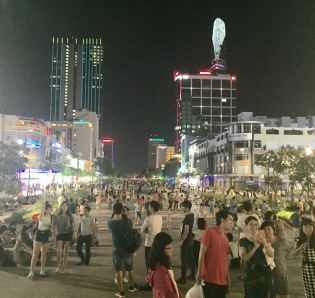The Fall of Saigon. Since Ho Chi Minh City was Saigon, and since we’re leaving Vietnam the day after “Reunification Day,” I feel it necessary to make a couple comments. Rarely is this event described as an American loss, but it was. The United States spent millions of dollars, killed millions of people, lost almost 59,000 of its own, and lost the war. (How would it feel to be Charles McMahon and Darwin Judge, the last American soldiers to be killed in Vietnam? Is the latter’s name not ironic?) But the Vietnamese don’t refer to victory, they call it Liberation Day or Reunification Day. Rather than proud, they seem humble. You can read more at the links above, about Operation Frequent Wind, watch The Fall of Saigon, read the plight of the Vietnamese Boat People, or research any of the many related topics. This Time article points out that we have not learned the lessons from the fall of Saigon as evidenced in Iraq & Afghanistan. Perhaps if we could see the loss, admit the failure, acknowledge the mistakes, and apologize for the horrors of war, then we might stop the madness, put the Military Industrial Complex out of business, and have peace – with honor or otherwise. (Bonus link.)
Wars after the American War. Perhaps the Vietnamese are humble about their victory against the United States because war contined. Immediately after the Americans left, they had to fight the Khmer Rouge in the Cambodia-Vietnam War until the late ’80’s. In 1979, there were battles on the border with China in the Sino-Vietnam War. It wasn’t until 1990 that Vietnam started to have peace and did not have to defend itself against aggressors. Since then they seem to have made great strides in developing their country. The rest of this post is about the rise of Saigon or Ho Chi Minh City…
In between trips to the Mekong, Cu Chi, Mui Né, etc., we stayed in HCMC/Saigon. We were in the Signature & Silverland Hotels. Here’s a view of the city from the former…
At a nearby restaurant the kids found their favorite toilet. (Note the control panel with buttons control a variety of posterior cleansing features.) And a shot of the Signature Hotel, phone/power wires, a hammer/sickle logo, and a road off of the road to HCMC…
On the road…
We had dinner with a friend, Swati, we met in Kochi. She’s from India, but lives in Saigon. Street food pic and a couple restaurants…
One of the sites in HCMC is the Saigon Post Office. Designed by Gustav Eiffel (of the tower) it is a beautiful old colonial building well cared for. Across the street is a cathedral.
Saturday night on Nguyen Hue Street in Ho Chi Minh City and the Ben Trang market…
The Silverland Hotel, one of our many tourist vans (which we love), a BBQ snack at a very cool restaurant (where you cook your own meal with a little personal BBQ), the view from the Silverland (since I showed the view from the Signature), a shot straight down at another building, etc…
We’re going back to Ho Chi Minh City two more times: tomorrow and when we get back from Cambodia before leaving for Sydney. I may add more pix here…
Study Questions:
- Read at least two links above and comment on the Fall of Saigon.
- Read two other links above and comment on the Fall of Saigon or the wars against Cambodia & China.
- Research Ho Chi Minh City. What is it like now?












































Wonderful pictures and words once again!!! Evie Guin phoned today and
said that Marilyn Jackson is sharing your pictures with her!!!!!!
Hooray for you, honeybunch!!
XO
LikeLike
according to the vietnamese goverment there were 1,100,000 north vietnamese and viet cong killed in the war.
LikeLike
You are perhaps questioning the number of Vietnamese killed in the war at 3 million? I was simply quoting the tour guide, but I believe the Vietnamese government also has stated there were 2 million civilian deaths which brings the total number over 3 million.
According to https://en.wikipedia.org/wiki/Vietnam_War_casualties…
“Also in 1995, the Vietnamese government released its estimate of war deaths for the more lengthy period of 1955 to 1975. According to the Vietnamese, Communist battle deaths totaled 1.1 million and civilian deaths of Vietnamese totaled 2.0 million. These estimates probably include battle deaths of Vietnamese soldiers in Laos and Cambodia, but do not include deaths of South Vietnamese and allied soldiers which would add nearly 300,000 for a grand total of 3.4 million military and civilian dead.[4]
A 2008 study by the BMJ (formerly British Medical Journal) came up with a higher toll of 3,812,000 dead in Vietnam between 1955 and 2002. For the period of the Vietnam War the totals are 1,310,000 between 1955 and 1964, 1,700,000 between 1965 and 1974 and 81,000 in 1975. (The estimates for 1955 to 1964 are much higher than other estimates). The sum of those totals is 3,091,000 war deaths between 1955 and 1975.[3]”
Interesting article that cites the number 3.8 million killed: http://www.theamericanconservative.com/articles/vietnam-a-war-on-civilians/
Specific information about American military killed in Vietnam: http://www.archives.gov/research/military/vietnam-war/casualty-statistics.html
LikeLike
Really love your documentation of Vietnam & reflections, thank you Randall & hugs to you four!
LikeLike